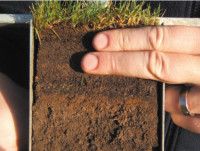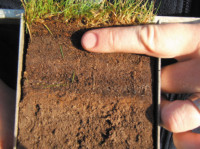Two fingers is bad ...
 Thatch is a Course Manager's worst nightmare. New expectations and demands for improved playing conditions are prime factors in the minds of users and managers alike.
Thatch is a Course Manager's worst nightmare. New expectations and demands for improved playing conditions are prime factors in the minds of users and managers alike.
The world of amenity and leisure is changing. New expectations and demands for improved playing conditions are prime factors in the minds of users and management alike.
Competition for members, societies and customers has never been fiercer. In golf terms, it's match play out there, head to head.
In recent months, a number of well imbedded Course Managers have had their positions terminated with many others being challenged by their individual chairmen, treasurers and captains, as pressure increases to secure revenues and committees ask "are we getting value from our Greenkeeper?"extent, and things are not getting better.
However, there are many factors which have a serious impact on a green's quality, none more so than the issue of thatch.
Thatch is a common problem throughout the continent despite the diversity of grass types and soil conditions which occur within the amenity turf culture.
Usually, one becomes aware of the presence of thatch through a deterioration in the playing surface. Significant changes are seen in colour, they become uneven, patchy and infested with weeds and moss. A soft or spongy feel to the turf is apparent when walking across the surface and, in extreme cases, one can see foot marks, or wheel marks from the machinery, left in the thatch.
Naturally, players begin to complain that greens are slow. Then the snowball effect begins. The club's management is anxious to retain its customers; hence pressure is placed upon the Greenkeeper to correct the situation.
Unfortunately, the instinct is to run screaming to established company representatives to supply a remedy, which undoubtedly takes the form of a salt fertiliser in an attempt to colour up and provoke good grass growth, only to then need fungicides to offset the resulting ingress of diseases or toxin build up within the soil, e.g. black layer, shallow rooting, root breaks, just to name but a few.
To discuss thatch and thatch removal or thatch control, it is necessary for us first to study how, where and why thatch forms.
This appears to be caused by many factors operating simultaneously. The following reasons for thatch accumulation have been given by agronomists and researchers worldwide for decades.
The modern approach of applying high salt materials of an inorganic nature. The use of excessively heavy applications of nitrogen (N) increases thatch development, particularly if applied in the wrong season and in adverse conditions, or for the wrong reasons!
To understand this one must appreciate that nitrogen causes cell elongation. The grasses produce abundant growth resulting in a soft, leggy, weak structure within the plant's cells, stems and leaves. The sugars that are produced within the leaves are not passed back to the roots due to the leaves being regularly removed by the operation of mowing. Therefore, the roots are never replenished, they become stressed and shallow. If you constantly feed the turf with the traditional granule salt based nutrients then the consequence is that you will inevitably stimulate soft, weak and susceptible poor plant growth, and that effects sustainability.
Over watering can also contribute to thatch since it can lead to rotting of the surface, inducing disease infestation. This is particularly evident when an accumulation of thatch is already evident.
A simple test of thatch is the 'finger test'. If your thatch is one finger's width deep you are okay. Two fingers or more and you have a problem!
A further cause of thatch is a compacted soil surface which, in itself, becomes a hindrance to the penetration of air, water and nutrient. At this point growth can vary significantly between waterlogging and drought until only the Poa annua (Annual Meadow Grass) or other challenging grasses or weed grasses survive and the remainder is thatch and moss. 
The end product of this problem can be seen all too often on sport turf surfaces throughout the entire world, let alone the UK. These soils have predominantly been allowed to become acid and are maintained by mowing and salt fertiliser feeding. Even some established turf specialists have recommended 8-0-0+Iron as a mini granule feeding programme to the turf manager!
The use of amine nitrogen provides the user with far greater control in the production of turf culture, with significantly less stresses on both the turf and that of the course manager.
Stoloniferous grasses, such as strong creeping bent grasses which have been bred from water meadow pastures, favour high water input. Along with regular nitrogen concentrates this will certainly result in the increasing accumulation of thatch, since these types of grasses regenerate quickly following the stresses of scarification and, after the new growth has begun, most of the old stems die off contributing to the organic matter accumulation.
Once established, thatch will form an extremely dense mat, restricting penetration and percolation of moisture, nutrition and dressings to the soil surface and consequently to the roots where the brains of the plant exist. In thatch, plant roots remain within the fibre content and are, therefore, shallow and close to the surface.
Thatch is the best possible breeding ground for disease and more serious problems that can occur on the soft, spongy surface of a slow putting green. Therefore, it is imperative that steps are taken to control thatch development.
Problems are caused by the non penetration of fertiliser through the thatch and the soil. Salt based inorganic fertilisers held within the thatch layer contribute to surface rooting since, as mentioned earlier, the grass roots will grow where the nutrients and moisture are.
Similarly, any dressings you intend to give to the soil will be difficult to control as many chemicals will be trapped and retained within the thatch and will be prevented from reaching the soil and, in particular, the root hairs which transport the required concentrations for a healthy plant.
 Fibrous turf also presents a problem in dry weather, as the fibre dries out much faster than the soil. The turf deteriorates quickly because the grass, under this situation, is shallow rooted. In dry conditions the players find it difficult to hold shots on to golf greens as the spongy nature tends to act like a spring board, bouncing the ball off the surface.
Fibrous turf also presents a problem in dry weather, as the fibre dries out much faster than the soil. The turf deteriorates quickly because the grass, under this situation, is shallow rooted. In dry conditions the players find it difficult to hold shots on to golf greens as the spongy nature tends to act like a spring board, bouncing the ball off the surface.
Aeration with the various tines will be absolutely essential in order to transfer moisture to the soil after any application of artificial or natural watering.
So much for how, why and when thatch accumulates!
The result of the accumulation is well known to us all. Its effect is a non uniform playing surface, which, in itself, is of poor quality. This is no longer acceptable to your committees, owners or managers and it should not be acceptable to the professional Turf Manager. Remind yourself that the whole green, pitch or facility must be fit for the playing of the particular game. It must have a true, smooth, even textured surface on which to play and have enjoyment.
Yet, one could argue that, in golf, it requires some hold for an approach shot. Hence, a little fibre is always acceptable but, of course, it still has to be managed or controlled. Act now or be challenged later!!
Further information from David H. Bates Agronomy Services. Tel: 07736 066031.
Email: DHBatesservices@aol.com
